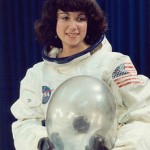Christa Mcauliffe
January 28, 2011 by USA Post
 Christa Mcauliffe, (CNN) – Twenty-five years ago today, Concord, New Hampshire, has been abuzz with enthusiasm that the teacher Christa McAuliffe was on the verge of making history.
Christa Mcauliffe, (CNN) – Twenty-five years ago today, Concord, New Hampshire, has been abuzz with enthusiasm that the teacher Christa McAuliffe was on the verge of making history.
Thousands of educators have asked to be the first teacher in space, but NASA chose McAuliffe, a 10th grade social studies teacher at Concord High School.
Micaela Pond, who was 17 years and McAuliffe’s neighbor at the time, remembers getting a return home one-day the teacher turned astronaut.
She still remembers her first laugh when McAuliffe said she wanted to go into space. “How is that possible?” she asked at the time. She remembers thinking: “Women do not go into space, [and] teachers certainly do not go into space.”
On January 28, 1986, the day of launch of the shuttle Challenger, Pond remembers the Concord High School auditorium full of students and media to watch the launch on television.
“We were all wearing party hats and whistles, and we were delighted with our master,” said Pond.
But the party did not last long. Challenger exploded 73 seconds into flight. McAuliffe and six astronauts aboard died.
“There was not a dry eye in the house, and I think the realization hit us pretty quickly,” it’s not good. “Pond recalled in a calm voice.
Merrimack resident Holly Cirillo, 33, was in third grade class from Barbara McNutt Thorton Ferry Elementary School and about 8 years old when the Challenger exploded.
She had gathered with his classmates and children from another class, who sat on their desktop computers while watching television at the front of the room. Cirillo said there was “a lot of preparation time leading up to it,” the program was heavy with details on the New Hampshire astronaut, Christa McAuliffe teacher and space exploration.
“It was really built with us,” she said. “I do not remember all the details, but we learned all about space and what it (McAuliffe) would do there.”
But when the shuttle exploded, the excitement changed to a stunned silence and confusion.
“There was a big sigh, and everyone was silent,” said Cirillo. “We had no idea what it was. Some children thought it happens, they lose pieces of the shuttle. We looked long before teachers close to the TV. Everyone was stunned. Nobody expected this. ”
Cirillo said the teacher in the class “did not know what to say” and did not know how to manage a classroom of third shock. She said she remembers the teacher cry, the comings and goings between the different classrooms and possibly try to change the subject.
Similar confusion is spent inside Room 16 at the Amherst Middle School that day.
“It was disbelief,” said Sam Giarrusso, the science teacher in seventh year that followed the launch on television with his students. “It was a great event, a professor of New Hampshire, and what happened? It was like 9 / 11. You watch and you start to see and ask, ‘what’s happening? What does this mean? ”
Giarruso, who has taught at Amherst College East for 33 years, said there was little discussion in class afterwards.
“From the perspective of a child, it is difficult to relate,” he said.
But Giarrusso said he remembers everything.
“We saw it happen,” he said.
So does Anthony DeMarco, a social studies teacher who watched the Challenger launch seventh school students Arc East on January 28, 1986. He said some children had been Christa McAuliffe, where she teaches.
“It was really devastating,” said DeMarco, who is now the leading Milford Middle School. “There was great hope and excitement around the first teacher in space. It was an incredible situation. At first, the children said, ‘what’s happening? “
_________________________________________
Please feel free to send if you have any questions regarding this post , you can contact on
Disclaimer: The views expressed on this site are that of the authors and not necessarily that of U.S.S.POST.




Comments